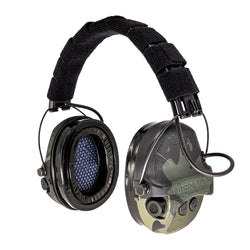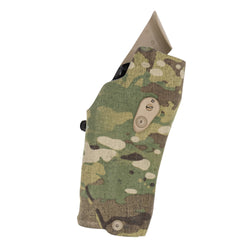The popularity of double-action pistols has waxed and waned and waxed again over the years as we discover then rediscover their merits and, in time, their demerits. As a class, double-action pistols are an older design, but one that refuses to go away with good reason.
If you are considering a handgun for duty, hunting, or personal protection, you might be torn between modern striker-fired handguns and hammer-fired double-action or single-action handguns. Each will have its advantages, both major and minor. Here we will discuss the origins of double-action pistols and the case for and against them today.
Double Action Handguns: The Original Race Guns
When I call double-action pistols the original race guns, I am not referring to them in a competition shooting sense, although they excel in that arena. Rather, the double-action platform, when it was developed, was meant to allow the shooter to fire more quickly than with existing designs. It is also worth defining what double action is and how it originated.
Double action originally refers to hammer-fired handguns and how the trigger operates the hammer. With single-action handguns, the trigger only serves the single function of releasing the hammer. Double action is a mechanism by which pulling the trigger cocks the hammer and releases it at the end of its travel.

Early revolvers and pepperboxes in the 1830s and 1840s were single action handguns that required the hammer to be cocked for every shot. This led to more deliberate shooting and allowed for a light, crisp trigger pull. But the extra step of cocking the hammer first added complexity and time to the draw stroke and the ability of the shooter to get quick follow-up shots without disturbing the sight picture.
In the 1840s, pepperboxes with a double-action mechanism like the Allen & Thurber and Manhattan were on the market and gave the user six shots as fast as the trigger could be pulled. Double-action revolvers like the Adams and LeFaucheaux were on the scene in Europe in the 1850s. Europe quickly went the way of double-action revolvers as they could be kept loaded in a safe manner and fired by simply pressing the trigger.

The US Military got around to a double-action revolver with the Colt M1892, the first semi-automatic pistols were just around the corner—the Borchardt, the Browning, the Luger, and, of course, the Colt M1911.
But the semi-auto, like the revolver before it, started its evolution as a single-action platform. Unlike double-action revolvers, early automatic pistols were not considered safe to carry in a manner that made them ready to employ immediately.
The Colt M1911, for example, required the hammer be cocked in order for the pistol to fire. A manual thumb safety and grip safety was included because the pistol could not otherwise be safely carried cocked with the light trigger pull a single action gun affords. But manual safeties were easy to forget while holstering and unholstering, and it quickly became practice to carry autoloading pistols with an empty chamber. It did not help that early pistols like these were not completely drop safe.

To answer these problems, Walther debuted the first commercially successful double-action pistol in 1929 with the Walther PP. The better-known and smaller Walther PPK was introduced in 1931. Together, these two handguns were among the first that could be safely carried and fired from the draw.
The Walther featured an exposed hammer and a hammer block safety mounted on the slide. Sweeping the safety down de-cocks the hammer without setting off the pistol. Sweeping the safety back up resets the trigger with the hammer down. From that position, the pistol can be carried and then shot by a long pull of the trigger. After the first shot, the hammer is automatically re-cocked by the slide, and it becomes a default single-action pistol until the pistol is returned to its safe position.
Taken together, the PP series set the pace for double action/single action (DA/SA) pistols as the design was co-opted for pistols like the Walther P38, the Russian Makarov, the Beretta 92, the Smith & Wesson 39, the Sig P220 series, and the Ruger P-Series.
Although most double-action pistols available today follow the Walther formula, not all do. The famed Walther P99 and later the Canik TP9DA are striker-fired handguns that are double-action. The trigger cocks and releases a striker, rather than a hammer. Some hammer-fired handguns like the Sig Sauer DAK series, S&W Bodyguard, and SCCY are double-action only without any single-action capability.
In Context: The Pros of the Double-Action Pistol
Times change. Modern semi-automatic pistols are more reliable and come from the factory with a number of safeties that prevent accidental discharge if dropped while fully loaded. Likewise, there are more handguns on the market today with passive safeties that negate the need for a manual safety that you might forget.
Striker-fired handguns from Glock, Sig, Springfield, among others, have negated some of the strengths that made double-action hammer-fired pistols appealing—namely, safety and the ability to keep the pistol in a condition to fire. That has been helped further by modern firearms training that emphasizes a straight trigger finger and rigid holsters with none of the pliability of leather and other options that could lead to an accidental discharge while holstering and unholstering.
But while time has changed, the conditions have essentially not, as double-action/single-action pistols are among the safest handguns to carry, but among the fastest to deploy without the need to fumble with safeties and switches.
The competition has gotten better in some ways and worse in others. Striker-fired pistols, even with trigger safeties, have shorter and lighter triggers than double-action guns. Without a manual safety, it can be a hazard to reholster if clothing and debris get in the way of the reholstering stroke.
Some shooters need a visible hammer on their firearm to see the condition it is loaded and ready to go. Others like the longer double-action trigger pull because it takes more effort to set the pistol off. This is a handy feature if a threat subsides before you need to press the trigger fully, and it adds an extra layer of safety when reholstering, where clothing or debris could interfere and unintentionally discharge a striker-fired or single-action hammer-fired handgun. For added safety, the hammer in its lowered position can be pushed down with the thumb to deactivate the trigger while reholstering.
Two Trigger Pulls: The Achilles Heel of the DA Platform
An ancillary issue that affects DA pistols over other platforms is the potential for ingress to get into the long pathway behind the trigger shoe, which can prevent the rearward movement of the trigger. With occasional inspection and cleaning, this is not an issue, but it is a point of attention that is less significant than single-action handguns, whose hammer channel is a more obvious and visible ingress point.
But the biggest disadvantage of the double-action pistol is also its advantage: the double-action trigger. The longer and heavier double-action trigger pull gives the user an additional margin of safety, but that same feature comes with a few downsides.
The single-action trigger pull in DA/SA pistols is superior to striker-action pistols, there is more mush in the take-up compared to dedicated single-action only handguns. For competitive work and hunting, the latter category of handguns holds strong.
Alternatively, the double-action trigger pull can be difficult for some shooters to pull. That pull is long and can be too heavy, particularly for small-handed shooters who can struggle to reach the trigger with a full firing grip on larger handguns like the Beretta 92 or Sig 220 series. The same can be true for those with dexterity issues in the hands that limit movement. Even some smaller handguns have deceptively heavy double-action pulls that can be impossible for some to pull.
Even among those who can set off a double-action pistol, there is still usually a problem of two different trigger pulls. Unless you own one of a handful of firearms that are double-action only, traditional DA/SA models have a heavier first pull and subsequent short and light pulls. It takes more follow-through and practice to run a DA gun effectively like a handgun with a more consistent trigger pull.

Shooting Better with the Double action handguns
Double-action handguns have unique advantages over conventional single-action and striker-fired pistols. Like striker-fired handguns, double-action guns can be carried ready to fire without the need for activating or deactivating a manual safety like a single-action gun.
On the other hand, the longer trigger pull adds an extra layer of safety for the shooter. The big disadvantage is the prospect of mastering two different trigger pulls, which requires more practice than the consistent triggers of single-action and striker platforms.
In my own shooting experiences over the last 20 years, I found my personal trick to double-action shooting is to dispense with the idea of using the pad of the trigger finger as you would with other designs and use the first crook of the finger for more leverage. It also helps to ride the trigger all the way back and then all the way out to reset, so you are not tempted to shift your grip and point of aim, and less likely to be surprised by differences in trigger pull.
Most important, though, is selecting the right DA pistol in the first place. Take your pick and ensure you can get a proper grip with enough finger on the trigger. Also, take stock of the trigger feedback and if the pistol has what you require, depending on your purpose. All things considered, if you are looking for your first or next handgun, don’t overlook the double action.









